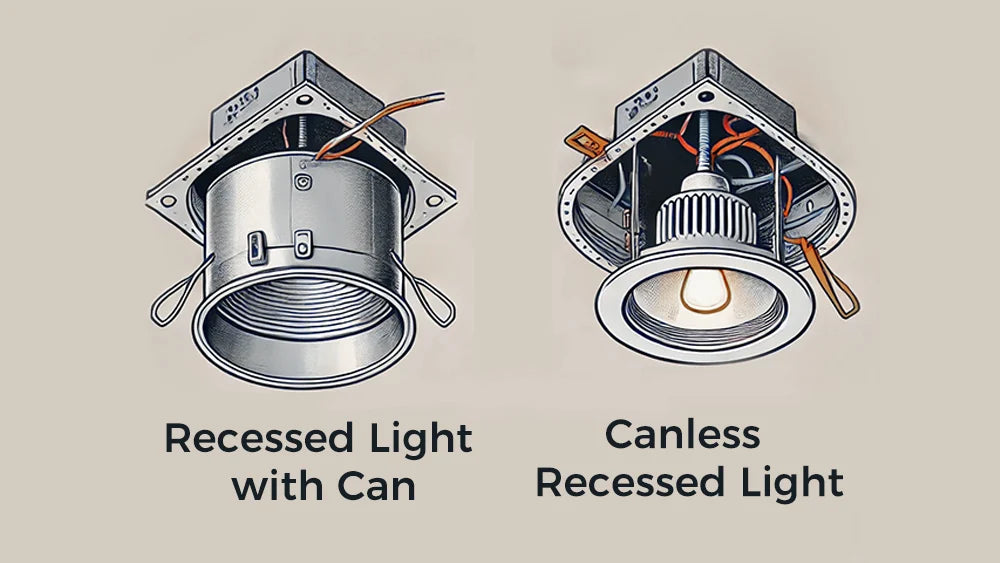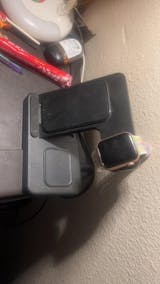In the arena of recessed lighting, you will find multiple attractive and compelling lighting solutions to decide between. The two most common types are can and canless recessed lighting. Many people don’t know how to choose.
In this blog, we will distinguish the direct differences between the two and help you choose the lighting fixture that suits you!
What Is Can Recessed Lighting?

Can recessed lighting is going to be one of the major types of recessed lighting you can choose to implement for your home or office.
So, what is it exactly? Canned recessed lights, also known as pot lights, are installed into a ceiling. They are housed in a metal cylinder that conceals the light source and any visible wires.
This housing container helps give the room’s light fixture a seamless, unobtrusive sort of look. To install a can recessed light, the metal can unit is contained within a hole in the room’s ceiling, which remains concealed after the installation is finished.
What Is Canless Recessed Lighting?

In contrast to canned lights, canless recessed lighting doesn’t use a cylindrical metal fixture. Instead, these types of lights are installed straight into a hole in a ceiling, with no housing structure surrounding the source of illumination.
This lighting design favors LED light bulbs, so most canless recessed lights do use LED technology. As you might guess, these LED bulbs boast advantages in energy efficiency and environmental friendliness.
Those who swear by canless recessed lights say that these lights immediately provide a room with a modern, 21st-century look, while at the same time, saving space and offering an uncomplicated, speedy installation process.
Can vs Canless Recessed Lighting: The Difference

1. Installation Process
Can Recessed Lighting: Installation is more complicated, requiring a hole large enough to accommodate the metal housing. The fixture needs to be fixed in place, and the wiring can also be complicated, usually requiring professional or advanced DIY skills.
Canless Recessed Lighting: Canless recessed lighting is much simpler to install. It has no housing design, and the LED fixture is directly wired, which usually does not require as many installation steps.
2. Aesthetic Appeal
Can Recessed Lighting: The metal casing of a can light creates a certain presence around the light source. Although it looks relatively flat after installation, the size of the light fixture itself is relatively obvious, especially in smaller spaces, and it will take up more visual space.
Canless Recessed Lighting: These lights have a sleek and simple appearance, which is perfect for modern interiors. Because they have no visible housing unit, they can blend seamlessly with the ceiling, presenting a clean, unobtrusive appearance.
3. Energy Efficiency
Canless Recessed Lighting: The energy efficiency of can lighting varies depending on the type of bulb. For example, halogen and incandescent bulbs are less energy efficient than LED bulbs. With LED bulbs, can lighting can be more energy efficient.
Canless Recessed Lighting: Generally designed with LED technology, can be more energy efficient than incandescent or halogen bulbs. LED canless recessed lights also last longer, contributing to overall energy savings and lower maintenance costs.
4. Cost
Can Recessed Lighting: If you're budgeting, keep in mind that can recessed lighting tends to cost more upfront. You've got that metal housing to pay for, and the installation isn’t exactly a walk in the park. On top of that, custom trims or specific bulbs can make the price tag a little steeper.
Canless recessed lighting: Due to its simplified design and installation process, canless recessed lighting is generally more affordable. However, since there is no separate housing when a canless light fails, the entire fixture must be replaced. Consequently, these lights can be quite expensive to replace.
5. Customizability
Can Recessed Lighting: The main benefit of recessed lighting is that there are a variety of options. You can choose from different trim styles (baffles, reflectors, and shower trims), as well as a variety of bulb types (LED, incandescent, or halogen).
Canless Recessed Lighting: In contrast, canless recessed lights have fewer customization options. Most canless recessed lights are LED one-piece designs, and different types of bulbs cannot be replaced. In addition, they are relatively limited in appearance size and light frame options.
6. Space and Ceiling Size Considerations
Can Recessed Lighting: A recessed light's metal housing requires a certain amount of ceiling space, which may limit its use in smaller rooms or tight spaces. It is better suited for larger rooms or rooms with adequate ceiling clearance.
Canless Recessed Lighting: If you’re dealing with a smaller room or low ceilings, canless lights are a dream. Since there’s no bulky housing, they fit right in without taking up precious space. Great for those smaller apartments or rooms where every inch counts.
7. Maintenance and Lifespan
Can Recessed Lighting: If the right bulbs, such as LEDs, are used, recessed lights can last for years. Bulb replacement is relatively simple, and the fixture's protective housing helps prevent damage. However, if the housing becomes damaged, repairs can be more complicated.
Canless Recessed Lighting: Canless fixtures are efficient and have a long lifespan, but the downside is that if an LED fixture fails, the entire fixture must be replaced. This can be more expensive than simply replacing the bulb in a can fixture, especially if the fixture is integrated into a larger fixture.
How to Choose?

If you’re stuck choosing between can and can-less recessed lights and can’t figure out which to choose, there’s no cause for alarm! An intuitive solution is to note the lighting areas that are most important for your situation and compare which type of lighting performs better in these metrics.
Someone whose main concerns are quick installation and energy efficiency, for instance, really cannot go wrong with canless lights, since these lights are fast to install and usually use LED bulbs.
By contrast, if your top priorities are customizability and protection against damage, can recessed lights are the clear winner on account of their variety of trims and bulb types, along with the added heat and moisture defenses of their metal containers.
Conclusion
Can and canless recessed lights both have outstanding advantages and noticeable weaknesses.
With can recessed lights, you gain flexibility in customization and stronger protection against lighting damage at the expense of compactness or a fast and simple installation. Canless recessed lights, on the other hand, give you a quicker and more affordable setup and more choice in size while sacrificing bulb selection and convenient light replacement.
Looking for high-quality, affordable recessed lighting solutions? Whether you prefer can or canless options, ComiLED offers modern, energy-efficient fixtures to fit your needs. You will find modern, aesthetically pleasing recessed light fixtures and energy-optimized LED lighting products in one convenient location.
Hot articles: What Can Cause Room Light to Flicker?






Share:
How to Change a Lightbulb in a Recessed Light?
How to Add Recessed Lighting to the Existing Ceiling?